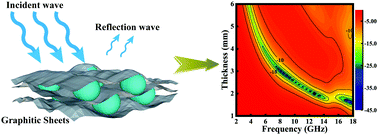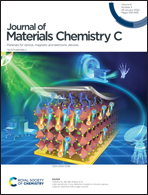Constructing a 3D interconnected Fe@graphitic carbon structure for a highly efficient microwave absorber†
Abstract
High-performance microwave absorption materials (MAMs) are attractive for eliminating the pollution and interference of undesired electromagnetic waves. Carbon/magnetic nanocomposites have been regarded as effective microwave absorbers owing to their synergetic effect of dielectric and magnetic loss. However, the complicated synthetic methods limit their applications in the MA field. In this study, a 3D interconnected Fe@graphitic carbon (Fe@GC) structure was synthesized via a facile two-step precipitation and chemical vapor deposition. Fe@GC shows the optimal reflection loss of −42 dB at 12.72 GHz with a layer thickness of 2.0 mm and the effective absorption bandwidth of 6.72 GHz from 11.28–18.00 GHz. These outstanding MA properties are due to multiple reflection behavior, the synergetic effects of magnetic and dielectric losses, and favorable impedance matching. In particular, the abundant interfaces between Fe cores and GC play important roles in enhancing dielectric loss. Moreover, the favorable impedance matching implies that more electromagnetic energy can be absorbed and converted to heat or other forms of energy as much as possible.



 Please wait while we load your content...
Please wait while we load your content...